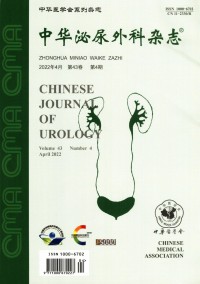多参数经直肠超声与多参数MRI对前列腺癌症诊断价值的比较研究
Q4 Medicine
引用次数: 0
摘要
目的比较多参数经直肠超声(TRUS)与多参数磁共振成像(MRI)对前列腺癌的诊断价值。方法回顾性分析2016年4月至2018年5月102例经直肠常规超声、横波超声弹性成像及增强超声等多参数超声造影、多参数MRI(包括T2加权弥散加权、动态增强MRI)及实验室检查的临床资料。平均年龄为66.1岁,范围为38.0 ~ 85.0岁。平均PSA为30.1 ng/ml,范围为0.4 ~ 227.0 ng/ml。平均PSAD为0.67 ng/ml2,范围为0.02 ~ 4.27 ng/ml2。选择TRUS引导下活检或手术的病理结果作为金标准。分析多参数TRUS和多参数MRI对前列腺癌的诊断性能,包括敏感性、特异性、阳性预测值(PPV)、阴性预测值(NPV)、准确性和受试者工作特征曲线下面积(AUROC)。结果本组前列腺癌62例,前列腺增生40例。平行多参数TRUS诊断前列腺癌63例,BPH 39例;多参数MRI诊断前列腺癌75例,BPH 27例。平行多参数TRUS的灵敏度为98.4%,特异度为70.0%,准确度为87.3%。多参数MRI分别为95.2%、60.0%和81.4%。平行多参数TRUS与多参数MRI的AUROC分别为0.842、0.776,差异无统计学意义(P=0.208)。结论多参数TRUS对前列腺癌的诊断价值不低于多参数MRI。关键词:前列腺肿瘤;前列腺癌;磁共振成像;Transrectal超声波;Multiparametric本文章由计算机程序翻译,如有差异,请以英文原文为准。
Comparative study on the diagnostic value of multiparametric transrectal ultrasound and multiparametric MRI in prostate cancer
Objective
The aim of the study is to compare the diagnostic value of multiparametric transrectal ultrasound(TRUS) and multiparametric magnetic resonance imaging (MRI) in prostate cancer.
Methods
The clinical data of 102 patients who received multiparametric TRUS (including conventional transrectal ultrasound, shear wave sonoelastography and contrast enhanced ultrasound), multiparametric MRI(including T2 weighted diffusion weighted, and dynamic contrast enhanced MRI) and laboratory tests from April 2016 to May 2018 were retrospectively analyzed. The average age was 66.1 years old, ranging 38.0-85.0 years old. The average PSA was 30.1 ng/ml, ranging 0.4-227.0 ng/ml. The average PSAD was 0.67 ng/ml2, ranging 0.02-4.27 ng/ml2. The pathology results from TRUS guided biopsy or surgical operation were chosen as gold standard. Diagnostic performance including sensitivity, specificity, positive predictive value(PPV), negative predictive value(NPV), accuracy and area under the receiver operating characteristic curve(AUROC)of multiparametric TRUS and multiparametric MRI in prostate cancer were analyzed.
Results
There were 62 prostate cancer and 40 BPH patients in our study. Parallel multiparametric TRUS diagnosed 63 prostate cancer and 39 BPH, and multiparametric MRI diagnosed 75 prostate cancer and 27 BPH. The sensitivity, specificity and accuracy of parallel multiparametric TRUS were 98.4%, 70.0% and 87.3%, respectively. And those of multiparametric MRI were 95.2%, 60.0% and 81.4%, respectively. The AUROC of parallel multiparametric TRUS and multiparametric MRI were 0.842 and 0.776, with no significant differences(P=0.208).
Conclusion
The diagnostic value of multiparametric TRUS was not inferior to multiparametric MRI in prostate cancer.
Key words:
Prostatic neoplasms; Prostate cancer; Magnetic resonance imaging; Transrectal ultrasound; Multiparametric
求助全文
通过发布文献求助,成功后即可免费获取论文全文。
去求助
来源期刊

中华泌尿外科杂志
Medicine-Nephrology
CiteScore
0.10
自引率
0.00%
发文量
14180
期刊介绍:
Chinese Journal of Urology (monthly) was founded in 1980. It is a publicly issued academic journal supervised by the China Association for Science and Technology and sponsored by the Chinese Medical Association. It mainly publishes original research papers, reviews and comments in this field. This journal mainly reports on the latest scientific research results and clinical diagnosis and treatment experience in the professional field of urology at home and abroad, as well as basic theoretical research results closely related to clinical practice.
The journal has columns such as treatises, abstracts of treatises, experimental studies, case reports, experience exchanges, reviews, reviews, lectures, etc.
Chinese Journal of Urology has been included in well-known databases such as Peking University Journal (Chinese Journal of Humanities and Social Sciences), CSCD Chinese Science Citation Database Source Journal (including extended version), and also included in American Chemical Abstracts (CA). The journal has been rated as a quality journal by the Association for Science and Technology and as an excellent journal by the Chinese Medical Association.
 求助内容:
求助内容: 应助结果提醒方式:
应助结果提醒方式:


